Boat Report Fluvial Magazine 2008
Reports : 1998 - 2008 - Français
A Britain in France
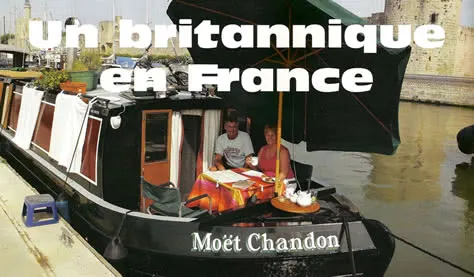 Less narrow than it appears to be, this boat is comfortable and sufficiently roomy for a pleasant river tour.
Less narrow than it appears to be, this boat is comfortable and sufficiently roomy for a pleasant river tour.
John and Irene Plunkett realize their dream on Moet Chandon, a cozy British wide beam narrow boat based in Carcassonne France.
John and Irene Plunkett, from Leeds in Yorkshire summarize their adventure. When we retired we said to ourselves, let's go! They hired a boat for the first time a 35-foot narrow boat in June 1996, for a ten-day holiday with John's brother and partner and their dog. They loved the holiday so much they decided they would like to own a boat some day. After searching the boatyards and waterways in the North & South of England over the coming years they found the boat of their dreams in their hometown! They bought this boat a "wide beamed" (3.1 metres x 17.5 metres) narrow boat in June 2001, after spending just one minute looking it over they knew it was the boat of their dreams.
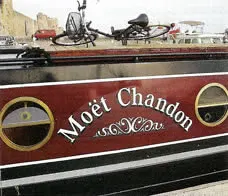
The boat was owned by a lock keeper who lived on it at the set of locks where he worked. He had the boat built in 1997 to his own specification to live on. Although Ledgard Bridge Boat Company built the boat he installed his own engine. Unfortunately the engine seized up after 3 months and was not reparable. The engine was lifted out and he lived on the boat and did not cruise. After buying the boat, John and Irene had the boat towed back with help from another narrow boat owner who had a huge engine. It was towed to the boatyard where it was built and had a new Yanmar 50 engine fitted, carrying out other works on the boat. The former owner became a good friend and over the next three years gave them lots of advice, tips and tuition on boat handling and maintenance.
FROM CARGO TO PLEASURE BOAT
The Moët-Chandon was built by Ledgard Bridge Boat Company in 1997 at 20km away from their former homes. Narrow boats were originally built in England to carry between 20 - 40 tonnes of cargo along the canals. They continue to build them but only as pleasure boats and sometimes as live boards.
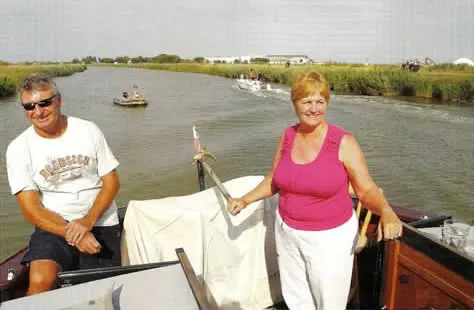
A traditional English narrow boat is 2.3 metres wide since a lot of the locks in the middle of the country are 2.3 metres wide. The original narrow boats built at the height of the Industrial revolution during the 18th/19th centuries would have been horse drawn. England then began an extensive program of construction of canals in order to meet the demands of industrial
development related to coal and the steam engine. But there is something that characterizes the narrow-boat beyond its narrowness “its tiller”. Nothing has changed since. The steering mechanism for the boat is a tiller and rudder. This is simplicity in itself and has virtually no chance of breaking down. The tiller bar is held in position by means of a brass pin. John and Irene have their own personalized pin in the shape of a dolphin and of course the English flag. Other small luxury, both functional and aesthetic, is "the canopy”.
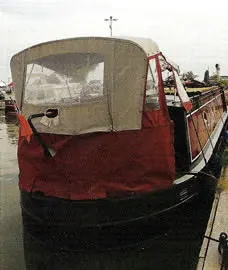
The stern of the boat is covered by a canvas canopy, which can be dismantled to just give cover protection from the sun or can be fully enclosed so the boat can be navigated in bad weather. It's also an added storage room when necessary. John has displayed his collection of old brass boat plates in the entrance. The couple installed a wooden deck on the roof. There is also a landing board, a gaffe and the bikes for shopping.
At the front of the boat, the owners have a very large green parasol for sun protection during their tea breaks (French joke). The deck is large enough for a small table and 4 chairs for eating and barbecuing throughout the spring and summer. You should know that in England, the price of a boat is calculated on its length and taxes too, so there is a strong propensity to expand the width and shorten the length of boats!
The dimensions of Moet-Chandon, 17m long and 3m wide, a vertical clearance of 2.50 metres and a draught of just 60cm provide an advantage to be able to navigate almost everywhere.
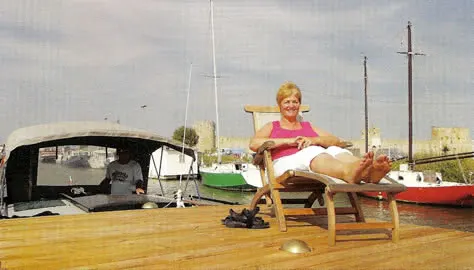
To arrive in France, the boat did not cross the English Channel but was transported from Newark in England on a large truck, and craned into the River Yonne by Jo Parfit at Migennes, which is where the Canal de Bourgogne meets the River Yonne not far from Auxerre. This was in late August 2004. From there they took the Canal de Bourgogne to Saint Jean de Losne to spend their first winter in France. The following spring the goal was Chagny where their Dutch friend Willem lives on his boat Cornelia. These fanatics have navigated over 1800km in France since August 2004. They will spend this winter in Carcassonne.
COZY BOAT
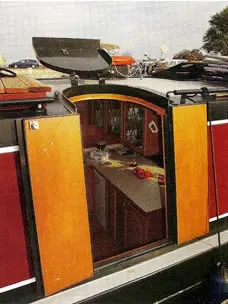
Although very elegant, the external decoration of the boat is rather sober and painted in traditional English narrow boat colours. The main side panels are painted in Mercedes Red surrounded by a White band and the rest is painted in Deep Coach Green. The roof and decks are in grey deck paint. The Moet Chandon lettering was hand painted by a traditional English sign-writer, who did a nice job on the shaded lettering and calligraphic ornaments.
John and Irene have painted the boat twice since buying, keeping it in the same traditional colours. In contrast to the old days when the living area was not more than a back cabin, it now covers the whole boat. A universe certainly very British, extremely neat and slightly out of date which give the boat its charms.
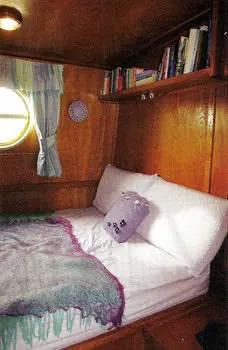
We can enter this "sweet home" through the front door, but also through an aesthetic and clever opening on the side. More precisely, you raise a hatch which then makes it possible to open the two doors and step right into the kitchen.
THE INTERIOR
Before retirement in December 2003 John & Irene carried out various modifications to the boat also personalising it to suit their needs and taste. The carpets were removed and replaced with a solid oak floor throughout.
The solid fuel stove in the saloon was taken out and a new diesel-burning stove fitted. A new Westerbeke 5.7kw generator was installed, making the boat totally self-sufficient. A new bathroom was installed incorporating washing machine and dryer. The interior of the boat incorporates a "Houdini Hatch" which is an opening skylight allowing fresh air and light in. There is also a side hatch, which also serves the same purpose.
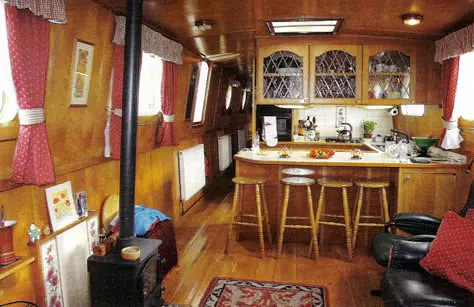
The floor throughout is solid oak in a deep warm colour to match the oak veneered panels and oak trip to the walls and ceilings. The kitchen units and cupboards in the saloon are also in oak. The large central work are in the kitchen is used as a dining table and bar. The kitchen incorporated a double gas oven and separate gas hob in green. The saloon is heated by means of a "Bubble" diesel stove and the rest of the boat is heated by Eberspacher central heating system with traditional radiators. They also have a satellite T.V. system. The saloon has a green leather settee and green leather reclining chair. Irene has a laptop computer linked to Internet with which she works on their web site and keeps in contact with friends and family by e-mail.
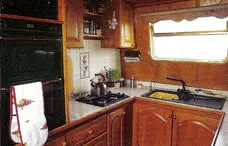
The bathroom now incorporated a washbasin in a vanity unity, electric flush w.c. and a curved shower enclosure. As stated earlier the washing machine and dryer are also in the bathroom. The diesel stove sits on a tiled hearth with tiled background to match tiles in the same colours as the kitchen. The floral pattern on the tiles is in the same colours as the curtains and the exterior of the boat. This boat is very comfortable and it is not surprising that it attracts admiring looks wherever it travels on the waterways of France.
Translated into English with help from, Willem, Stephanie and John Plunkett.
- Text and Photos Florence Chevallier
- Fluvial-Magazine N° 179 february 2008, Pages 48 - 50
- Bateau de rêve, narrow boat, Canal du MIDI
- Manufacturer : Ledgard Bridge Boats
- Source : Fluvial Magazine (French)